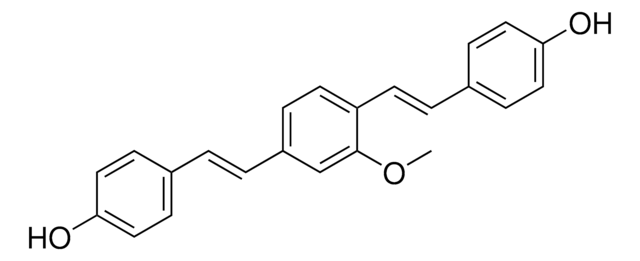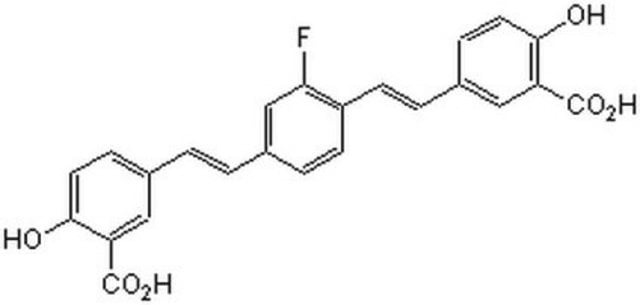おすすめの製品
product name
X-34, ≥90% (HPLC)
品質水準
アッセイ
≥90% (HPLC)
形状
powder
色
white to beige
溶解性
DMSO: 2.0 mg/mL, clear
保管温度
2-8°C
SMILES記法
OC(C=C1)=C(C(O)=O)C=C1C=CC2=CC=C(C=CC3=CC=C(O)C(C(O)=O)=C3)C=C2
生物化学的/生理学的作用
Fluorescent, amyloid-specific dye
X-34 (1,4-bis(3-carboxy-4-hydroxyphenylethenyl)-benzene) is one among the small-molecule γ-secretase modulators (GSMs) involved in lowering Aβ42 levels (the 42-residue isoform of the amyloid-β peptide). X-34 has also been used to visualize intracellular immunoreactive deposits with classic amyloid fibrillar ultrastructure in living transgenic Caenorhabditis elegans animals. It is also used as a histochemical stain for determining pathological changes in Alzheimer′s disease (AD).
X-34 is a fluorescent, amyloid-specific dye. It binds at a different site than Pittsburgh Compound B and is a highly fluorescent marker for beta-sheet structures.
保管分類コード
11 - Combustible Solids
WGK
WGK 3
引火点(°F)
Not applicable
引火点(℃)
Not applicable
適用法令
試験研究用途を考慮した関連法令を主に挙げております。化学物質以外については、一部の情報のみ提供しています。 製品を安全かつ合法的に使用することは、使用者の義務です。最新情報により修正される場合があります。WEBの反映には時間を要することがあるため、適宜SDSをご参照ください。
Jan Code
SML1954-5MG:
SML1954-25MG:
SML1954-VAR:
SML1954-BULK:
試験成績書(COA)
製品のロット番号・バッチ番号を入力して、試験成績書(COA) を検索できます。ロット番号・バッチ番号は、製品ラベルに「Lot」または「Batch」に続いて記載されています。
Substrate-targeting ?-secretase modulators
Kukar TL
Nature, 453, 925-929 (2008)
Andy P Tsai et al.
Neurobiology of disease, 153, 105303-105303 (2021-02-26)
Alzheimer's disease (AD) is a progressive neurodegenerative disorder characterized by cognitive decline, robust microgliosis, neuroinflammation, and neuronal loss. Genome-wide association studies recently highlighted a prominent role for microglia in late-onset AD (LOAD). Specifically, inositol polyphosphate-5-phosphatase (INPP5D), also known as SHIP1
Marcus Bäck et al.
Chemistry (Weinheim an der Bergstrasse, Germany), 22(51), 18335-18338 (2016-11-04)
Deposits comprised of amyloid-β (Aβ) are one of the pathological hallmarks of Alzheimer's disease (AD) and small hydrophobic ligands targeting these aggregated species are used clinically for the diagnosis of AD. Herein, we observed that anionic oligothiophenes efficiently displaced X-34
Chantal M Ferguson et al.
Alzheimer's & dementia : the journal of the Alzheimer's Association, 20(4), 2632-2652 (2024-02-20)
The most significant genetic risk factor for late-onset Alzheimer's disease (AD) is APOE4, with evidence for gain- and loss-of-function mechanisms. A clinical need remains for therapeutically relevant tools that potently modulate APOE expression. We optimized small interfering RNAs (di-siRNA, GalNAc)
Visualization of fibrillar amyloid deposits in living, transgenic Caenorhabditis elegans animals using the sensitive amyloid dye, X-34
Link CD
Neurobiology of Aging, 22, 217-226 (2001)
ライフサイエンス、有機合成、材料科学、クロマトグラフィー、分析など、あらゆる分野の研究に経験のあるメンバーがおります。.
製品に関するお問い合わせはこちら(テクニカルサービス)








